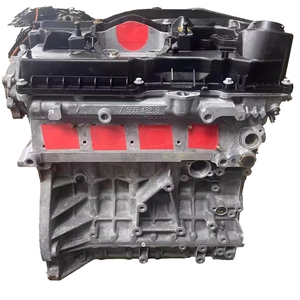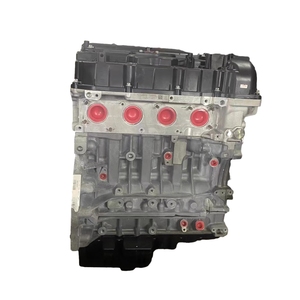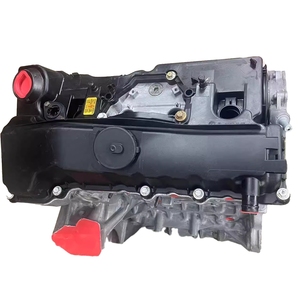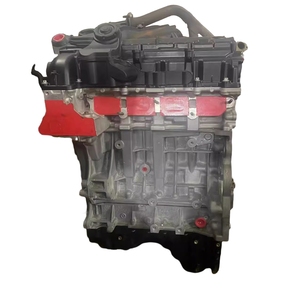
All categories
Featured selections
Trade Assurance
Buyer Central
Help Center
Get the app
Become a supplier

(2673 products available)
















































The BMW 320d engine is a four-cylinder diesel engine found in the BMW 3 Series. The standard spec and performance may differ based on the specific model and production year. Typically, the BMW 320d engine comes in two basic types.
BMW 320d bi-turbo engine
The BMW 320d Bi-Turbo engine is a high-performance variant of the standard 320d engine. It employs two turbochargers, working in unison to boost engine power and efficiency. The first turbocharger is smaller and spins quickly to generate boost at low engine speeds. The second turbocharger is larger, providing more airflow at higher engine speeds. This setup allows for a broader powerband and minimizes turbo lag. As a result, the BMW 320d Bi-Turbo engine delivers more torque and power, enabling quicker acceleration and responsiveness.
BMW 320d xDrive engine
The BMW 320d xDrive engine is another variant of the standard 320d engine. It features BMW's xDrive all-wheel-drive technology, distributing power to all four wheels for enhanced traction and stability. The 320d xDrive engine may have similar power outputs as the standard 320d engine. However, the xDrive system improves handling and control, especially in challenging road conditions like rain or snow. Furthermore, the 320d xDrive engine often features other performance-oriented elements, such as a well-tuned suspension system, to cater to the needs of driving enthusiasts.
Some other variants of the BMW 320d engine include the BMW 320d Touring, BMW 320d Gran Turismo, and BMW 320d M Sport models. The specs and performance of these cars may differ based on the model and production year. Generally, they all come with a 2.0-liter 4-cylinder diesel engine that produces between 114 hp and 187 hp and a 6-speed manual transmission or 8-speed automatic transmission.
The BMW 320d specifications are as follows:
Engine
The BMW 320d has a 2.0-liter, four-cylinder turbocharged diesel engine. The engine generates 148 to 195 horsepower and 280 to 332 lb-ft of torque.
Performance
The BMW 320d performs from 0 to 60 mph in 6.8 to 8.9 seconds. The top speed of the car is 130 to 155 mph.
Transmission
The BMW 320d comes with an 8-speed automatic transmission. The transmission has rear-wheel drive or all-wheel drive (xDrive).
Fuel Efficiency
The BMW 320d has a fuel rating of 36 to 48 mpg in the city and 50 to 64 mpg on the highway.
Dimensions
The BMW 320d has a length of 182.5 inches, a width of 71.3 inches, and a height of 56.3 inches. The wheelbase is 111 inches.
Weight
The BMW 320d weighs between 3,200 to 3,500 pounds.
Brakes
The BMW 320d has front brakes of 13.0 inches in diameter and rear brakes of 12.6 inches in diameter.
Wheels and Tires
The BMW 320d has standard 17-inch alloy wheels and optional 18- or 19-inch wheels. The car comes with 225/50 R17 tires, with optional 225/45 R18 or 225/40 R19 tires.
Interior
The interior of the BMW 320d has a 12.3-inch digital instrument cluster, a 14.9-inch central touchscreen display, a head-up display, and a Harman Kardon surround sound system.
Safety
The BMW 320d has safety features such as frontal collision warning, active cruise control, blind spot detection, lane departure warning, and parking assist.
Car owners can follow the following procedures to maintain the BMW 320d engine:
Choosing the correct BMW 320D engines can be an overwhelming errand, particularly with such countless choices accessible. Notwithstanding, it is essential to consider a couple of elements while choosing the right one for the business needs. Here are a few hints to direct the choice system.
By considering these elements, businesses can choose the right BMW 320D motor that meets their necessities and financial plan. Invest some energy exploring and contrasting various motors prior to pursuing the last choice.
Replacing the BMW 320d engine is not a simple task that can just be done by anyone. It requires expert knowledge, experience, and special tools. However, if it gets to a point where it has to be replaced, here are some steps to guide:
Preparation
This involves gathering all the necessary tools that will be used for the replacement work. Engine hoist, jack stands, jack, torque wrench, and socket set among others. Also, the new engine to be installed should be thoroughly checked, tested, and prepared to ensure it is in good condition.
Disconnecting
Disconnect all the cables and hoses connected to the old engine. These include electrical connections, cooling system hoses, fuel system hoses, and air intake connections. Once everything is disconnected, the old engine can be lifted out of the car using a hoist.
Mounting the new engine
Once the old engine has been removed, the new engine can be mounted onto the existing engine mounts. Then, the hoist is used to secure the engine to the mounts and ensure that it is aligned properly.
Reconnecting
Once the new engine has been mounted, all the disconnected cables and hoses are connected. This includes electrical connections, cooling system hoses, fuel system lines, and air intake connections. Make sure that every connection is secure and free from leaks.
Oil and coolant
Once the new engine has been installed and all the connections are done, the oil and coolant have to been filled. The engine requires regular maintenance to keep it running smoothly and in good condition.
Final checks
Once everything is done, a final check is required to make sure everything is in place. This includes checking for leaks, ensuring all connections are secure and verifying that the engine is running properly.
Q1. How can I make my BMW 320d engine more powerful?
A1. The 320d's BMW diesel engines are developed to meet the various requirements of clients. They, however, have a common restriction on their desire to be more powerful. The engines may be more powerful by installing an engine upgrade kit, new turbochargers, or intercoolers. Remapping the engine control unit can also increase power. These modifications can increase the engine's power output to meet the requirements.
Q2. What is the maintenance schedule for a BMW 320d engine?
A2. The 320d engine, like any other BMW engine, requires constant monitoring and maintenance at regular intervals. Depending on the model, the first maintenance service is provided between 10,000 and 15,000 kilometers or 12 months, whichever comes first. After the first service, every maintenance service will be scheduled after 20,000 kilometers or 24 months, and the interval must be strictly followed for the engine to perform well.
Q3. What are the signs of a failing BMW 320d engine?
A3. The signs of a failing BMW 320d engine are common and easy to spot. They include strange noises from the engine like knocking and rattling, warning lights on the dashboard like the check engine light, difficulty starting or engine cranking slowly, decreased acceleration or power loss, excessive exhaust smoke, burning oil or smell, and vibrating or shaking. Once these signs are noticed, consult a mechanic to look into the situation.
Q4. How can I source spare parts for the BMW 320d engine?
A4. Spare parts for the 320d engine can be obtained from authorized BMW dealers, local auto parts stores, online retailers, and specialty BMW parts suppliers. When sourcing the spare parts, ensure they are compatible with the specific model of the 320d engine in use.
The web search volume for the keyword "bmw 320d engine" has shown significant growth, averaging 40 monthly web searches with a dramatic one-year change of 750%. Over the past three months, the web search volume has surged by 467%. Analyzing the 12-month data reveals a fascinating pattern of fluctuation, with notable peaks in October and November 2024, reaching up to 170 web searches from a low of 10 web searches in May and August.
Throughout the year, the web search volume for "bmw 320d engine" experienced various highs and lows, indicating seasonal trends and specific periods of heightened interest. For instance, the volume remained relatively stable at 20 web searches from December 2023 through July 2024, except for a dip in May. However, from September 2024 onwards, there was a noticeable increase, peaking in October and November. This suggests that certain times of the year, possibly aligned with vehicle maintenance cycles or market releases, drive more interest in this specific engine model.
The detailed monthly breakdown highlights key periods of increased activity, which could be linked to specific events in the automotive industry or consumer behaviors related to vehicle servicing and upgrades. This trend analysis is crucial for businesses and marketers in the vehicle parts and accessories category, as it helps in forecasting demand and planning marketing strategies accordingly.